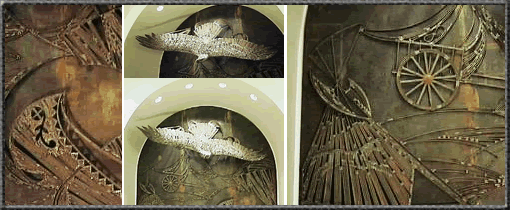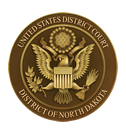
Context
With the coming of the new millennium, the minds and hearts of humanity are drawn to contemplate and ponder, all at once, the world's past, present and future. In the case of the art project for the Bismarck Federal Building, we necessarily think about the various elements which have contributed to the development of North Dakota over the years, as well as what will be integral to shaping its future. Thus, the challenge is: how do we show--in the true visual sense--the events of the past, the reality of the present and the optimism which must encourage future generations of North Dakotans?
Method
The chosen method to visually display North Dakota's past, present and future is a 12 ft. By 13½ ft. Relief emerging from the central wall of the main entrance of the Bismarck Federal Building. The mission of the piece is to intrigue the intellect as well as to bring hope to the hearts of those who experience this visual image simply entitled, "Millennium". Within "Millennium", we contemplate the formation of North Dakota as we immediately notice the faces of the many people and cultures which came together to make their present lives and to discover their futures in North Dakota. We cannot help but to specifically recall the Indigenous Peoples, the Voyageurs, and the Pioneers, all which have contributed to social, economic and cultural milieu which is North Dakota.
In looking at the relief more closely, there are several symbols which can be distinguished with particular meaning. "Millennium: contains the symbols of a tepee, an earth lodge, an oxcart, an eagle, a canoe and a plow to illuminate the importance of the different people and cultures which contributed to the development of our state. The tepee and earth lodge represent the Indigenous Peoples who have inhabited North Dakota for many centuries. Specifically, the tepee illustrates the tribes of the plains and the earth lodge stands for the Mandan people of the Missouri River. The eagle represents American's national symbol (as well the Native American symbol for honor, valor and blessings from the Creator). The canoe represents the coming of the western world to the prairie by way of the major water routes (the Red River and the Missouri River). The oxcart represents the Voyageur and their intermingling with the Native peoples and the resulting Métis People. The plow represents the early Pioneers which settled and homesteaded North Dakota with hopes and dreams of a better future for their families.
To evoke the inner emotion of those who look upon "Millennium" and wonder how those early inhabitants survived on the sometimes harsh North Dakota prairie despite many hardships; and to challenge the very intellect of those who contemplate what really has gone on in molding the Peace Garden State, is what this piece of work is all about. It is our desire that "Millennium" will be a constant source of hope and inspiration to the future generations of North Dakotans as they realize what has transpired to bring our state this far, and as they realize what will need to be accomplished in order to move our state ahead. As we visit and absorb this historic explanation, we will be reminded that we can achieve and strive as those before us have, and as the strong and courageous example they have set.
Symbolism
- CANOE ON A RIVER - Coming of new peoples
- TEPEE AND EARTH LODGE - Indigenous inhabitants
- OXCART - The Voyageur and The Métis people
- PLOW - Hope of The Pioneer
- EAGLE - America's National Symbol
Respectfully,
Ben W. Brien
Turtle Mountain Métis Artist
